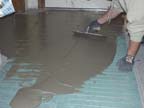

One of the luxuries that has been growing in popularity among homeowners and design professionals is the inclusion of electric floor warming in bathrooms and popular family gathering and entertaining spots, such as kitchens, family rooms and sunrooms. Spurred on by the relatively recent introduction of the new easy-to-install roll- and mat-based warming systems, floor warming is rapidly becoming a “must have†for anyone in the process of installing tile and stone floors. Obviously, most homeowners would prefer to step out of a shower or bath onto a soothing, pre-warmed stone floor, making floor warming an easy up-sell for tile and stone floors in all areas of the country.
Keeping the installer in mind
The new ultra-thin electric systems are designed to be installed on top of the sub-floor and directly beneath the stone tiles. In these cases, a mesh backing allows the system to be quickly laid out and affixed to the sub-floor by the tile contractor immediately prior to installation of the actual stone tiles. There is no need for a heating specialist, and most installations can be completed by a tile installation pro the first time -- without any prior training.
Unlike hydronic radiant floor heating systems, which are typically used in whole-building new construction heating applications, electric systems offer the flexibility to be added to individual rooms throughout the house. They can be installed where and when they are desired, as long as the system is in tandem with a new floor covering installation or the replacement of an existing floor.
Both roll and mat systems come with power leads that are connected back to a thermostat or other control for final system power hook-up. As such, it is recommended that final electrical work be performed by a qualified, licensed electrician.
Of the three forms of electric floor heating systems (cable, rolls and mats), the roll system appears to be the favorite among flooring installers, combining ease of installation with the ability to be fitted quickly around permanent fixtures such as tubs, shower stalls, vanities and cooking islands. A tight fit can be an important feature for a homeowner, as heat does not travel far beyond the boundaries of the system. Fitting of the roll system is achieved through a simple process that involves cutting the fiberglass mesh backing to which the heating cables are affixed. After this, the installer conducts a series of turns and flips to cover any floor area and shape.
One major benefit of electric floor warming is its cost-effective operation. The energy consumed by a system warming an average bathroom floor is similar to that required to power a standard light bulb. To warm a generously sized bathroom will cost less than 15 cents a day with a full three-hour “on†cycle. Because 100% of the energy consumed by a system goes into producing heat, there is no venting of unburned gases or particulates into the atmosphere, as with traditional heating systems.
Those unfamiliar with electric floor warming will find a wealth of information readily available from industry manufacturers and associations. Larger companies offer online information resources, installation videos and installer certification programs.

Best installation practices
When installing stone over an electric floor warming system, a few things should be considered to ensure a successful installation: